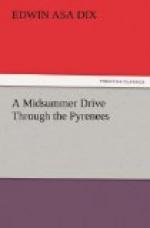III.
The past of Bearn, like an ellipse, curves around two foci. One is the town of Orthez,[14] the other, the later city of Pau. The hero, the central figure, of one is Gaston Phoebus, Count of Foix; that of the other, Henry of Navarre.
[14] Anciently written Ortayse, afterward Orthes.
These are the two great names of Bearn. Each lights up a distinctive epoch,—Gaston, the fourteenth century, Henry, the sixteenth.
* * * * *
In two hours after leaving Bayonne, the train has come to Orthez. There is little splendor in the old town as one views it to-day; yet in Gaston’s time it was the capital of Bearn, successor of the yet older Morlaaes, and a centre for knights and squires and men-at-arms, a magnet for pilgrims and noble visitors from other countries, attracted by its fame. There were jousts, tourneys, hunts, banquets. The now broken walls of the old Castle of Moncade on the hill have sheltered more glittering merrymakings than those of Kenilworth or Fuenterrabia. But decay never surrenders an advantage once gained; the castle is dying now; dull modern commonplace has enfolded the once bright town below; and this Orthez is to-day at best but a lounging-place for the pessimist. We shall love better Pau, its rival and successor, still buoyant and prospering, rising not falling. “Good men study and wise men describe,” avers Ruskin, in a more than half-truth, “only the growth and standing of things,—not their decay. Dissolution and putrescence are alike common and unclean ... in State or organism.”
For all that, Orthez and its traditions are too significant to hasten by. Nowhere is the picture of mediaeval life more strongly illuminated; in no spot shall we more fitly pause to summon back the inner past of the Pyrenees we are approaching. But we would linger over it only as it was in its best days, and leave to others the drearier story of its decadence.
It is Froissart, the old historian and traveler, genial, story-loving Sir John, who tells us most about Orthez and Gaston. Orthez, as the capital of Bearn, was in his time, at its meridian, (it was afterward supplanted by Pau,) and Gaston Phoebus, known as the Count de Foix, was lord both of Beam and of the neighboring county of Foix. It was precisely five hundred years ago, come next St. Catherine’s Day, that the old chronicler alighted from his horse here in Orthez. He was come on a visit to the count, well introduced, and seeking further material for his easy-going history of the times; knowing that foreign knights assembled in Orthez from all countries, and that there were few spots more alive to the sound of the world’s doings or better informed in the varying gossip of wars and court-craft.




